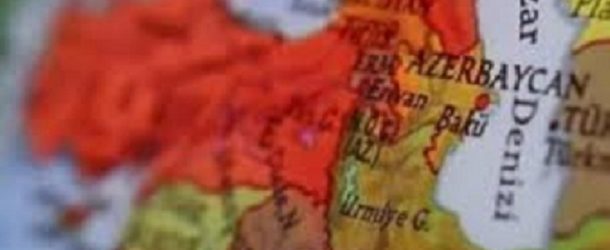The conflict between Azerbaijan and Armenia over Nagorno-Karabakh remains to be one of the most controversial issues of the twentieth century. Although the Versailles Peace Conference recognized Nagorno-Karabakh as part of the Azerbaijan Democratic Republic of 1918–1920, Armenia did not abandon its demand on the territory. After two years controversies, when the South Caucasus countries became part of the Soviet Union at the beginning of 1920s, Nagorno-Karabakh was again flagged as a topic of discussion. At the result, plenum of Kavbureau CC RCP(b) (Caucasus Bureau of the Central Committee of the Russian Communist Party of the Bolsheviks) decided to leave Nagorno-Karabakh within the territory of Azerbaijan SSR according to the decree of the July 5, 1921. Further in 1923, Nagorno-Karabakh was granted with an autonomous status.
However, this attempt of the Soviet leadership did not stop hostility between the two nations over Nagorno-Karabakh, just prevented direct clash for a while. Despite several attempts of the Armenian to annex Karabakh to Armenian SSR during the Soviet Union, it was after reform programs of glasnost and perestroika of Mikhail Gorbachev that Armenian SSR found a new momentum that provided the country with the opportunity to openly express its territorial claims against Azerbaijan. Although, in comparison not only to other mountainous regions of the Soviet Union, but also to the Azerbaijan as a whole the living standard in Nagorno-Karabakh was relatively high, Armenia was arguing that Armenians who were living in the Nagorno-Karabakh region were deliberately discriminated by the Azerbaijani leadership. Thus, on 20 February 1988, the Regional Soviet of Nagorno-Karabakh decided to transfer the region to the sovereignty of Armenia. This attempt of Armenia was rejected not only by Azerbaijan SSR, but also by the Supreme Soviet of the USSR and the Central committee of the CPSU with reference to the Article 78 of the USSR Constitution. The Article 78 of the Constitution was insisting that only 15 Soviet Union republics had the right of secession from the Soviet Union, but the autonomous republics or oblasts, belonging to the union republic, did not have the right to secede or unify with other(s) without the consent of the union republic that they were subjected. Meanwhile, as Erik Melander argues, “Soviet leaders opposed Armenian designs in Nagorno-Karabakh because of the risk that similar demands could be made by various regions in the Soviet Union, thus destabilizing the whole state… Gorbachev, however, was [also] worried that the large-scale use of force would jeopardize his reform program.” However, while taking no notice to the indication of the USSR Constitution and the concerns of Soviet leadership, Armenian side used the Soviet Law of 3 April 1990 “on the Procedures for Resolving Questions Related to the Secession of Union Republics from the USSR” as a legal basis for secession Nagorno-Karabakh from Azerbaijan and began to create their political structures within the region, which, according to scholars, explicitly violated not only above-mentioned article of the Soviet Constitution, but also the 1990 April Law per se. However, from that time on, Armenians possessed unconstitutional government over Karabakh and following the collapse of the Soviet Union, the war broke out between Azerbaijan and Armenia and lasted until the cease-fire agreement of May 1994, which caused serious material and moral damage.
On September 24, 1991, the Armenian military, with the support of the 366th Regiment, attacked the villages of Imarat and Garvand in the Aghdara region, killing Azerbaijanis with special cruelty and expelling the people from their homes. The most considerable armed violence and genocide by Armenians against Azerbaijanis took place with the Khojaly events. In late 1991, Khojaly was blocked by Armenians. Armenians closed all roads, destroyed communication lines and cut off the power supply—the people living here communicated with other cities by helicopter telephones. However, in the same year, after the shooting down of the Mi-8 helicopter, the number of helicopters arriving here also decreased. All weapons were confiscated from the people, and the gendarmerie forces operating in Khojaly were disbanded. A few people had only a total of 50-60 weapons left. On the night of February 25-26, 1992, Armenian forces attacked Khojaly and, with the support of the 366th Russian Regiment, destroyed the city of Khojaly.
After that, the Azerbaijani-Armenian Nagorno-Karabakh conflict escalated, and Armenian forces occupied Nagorno-Karabakh and seven surrounding regions until 1994, killing Azerbaijanis and expelling them from their homes. At that time, Iran, which was trying to meditate, did not react severely to the occupation of Azerbaijani lands by Armenia.
The Nagorno-Karabakh War traced serious physical, material, and moral consequences for Azerbaijan. The result of the war was the breach of the territorial integrity and inviolability of Azerbaijan by Armenia. According to official statistics of Azerbaijan, the overall occupied and affected territories of Azerbaijan at the result of war was 17, 000 sq. km. (10, 563 sq. miles), approximately 20 %, which includes: the Nagorno-Karabakh region, the territory of the former NKAO that was abolished in 1991 by Azerbaijan; Seven occupied regions of Azerbaijan surrounding Nagorno-Karabakh: Lachin, Kelbajar, Agdam, Fizuli, Jabrail, Gubatli, and Zengilan; Territories of Gazakh, Agstafa, Tovuz, and Gedebey that bordering with Armenia; Territories of 4 regions that bordering with the Line of Contact: Terter, Goranboy, Agjabedi, and Beylagan; Territories of the administrative regions of the Nakhchivan Autonomous Republic, a landlocked enclave of Azerbaijan surrounding with Armenia, Iran, and Turkey.
The United Nations (UN) has adopted four resolutions (822, 853, 874, 884) on the Nagorno-Karabakh conflict, and its terms have not yet been fulfilled. In the recent debates, Armenian Prime Minister Nicol Pashinyan stated that the conflict is happening between the so-called Nagorno-Karabakh Republic and the Republic of Azerbaijan. However, these four resolutions explain the real situation and declare that the dispute is not happening in Nagorno-Karabakh; this is the international conflict caused by Armenia. Firstly, in all resolutions, Nagorno-Karabakh is considered the territory of the Azerbaijan Republic. Secondly, all four resolutions start with the deterioration of relations between Armenia and Azerbaijan, and then the escalation of armed conflict. The UN Security Council provides a good understanding of who is involved in the conflict by stressing the sovereignty, territorial integrity, and inviolability of international borders of all states in the region. Such texts are not written in the context of internal conflicts. Moreover, the Security Council emphasized that there is a threat to the sovereignty, territorial integrity and international borders of Azerbaijan.
Today, not only the Nagorno-Karabakh region, but surrounding territories also are extremely militarized. Clashes in the region are a serious threat to the security of the peoples who are living there closely. Armenians authorities’ non-compliance with international law also creates conditions for the proliferation of terrorist groups in the region. The settlement of the Nagorno-Karabakh conflict under international law will ensure the security of the region and the effectiveness of economic and humanitarian assistance.
Considering the slowdown in peace talks in Nagorno-Karabakh conflict, the failure of the OSCE Minsk Group, the unfair treatment of the Western media on Nagorno-Karabakh conflict, repeatedly nurturing Azerbaijan’s territorial integrity with an unreasonable attitude by Armenia, makes the region more unstable and increases border clashes and as in the past, the region will not lead to multi-directional change.
Nisa MAMMADOVA
























































